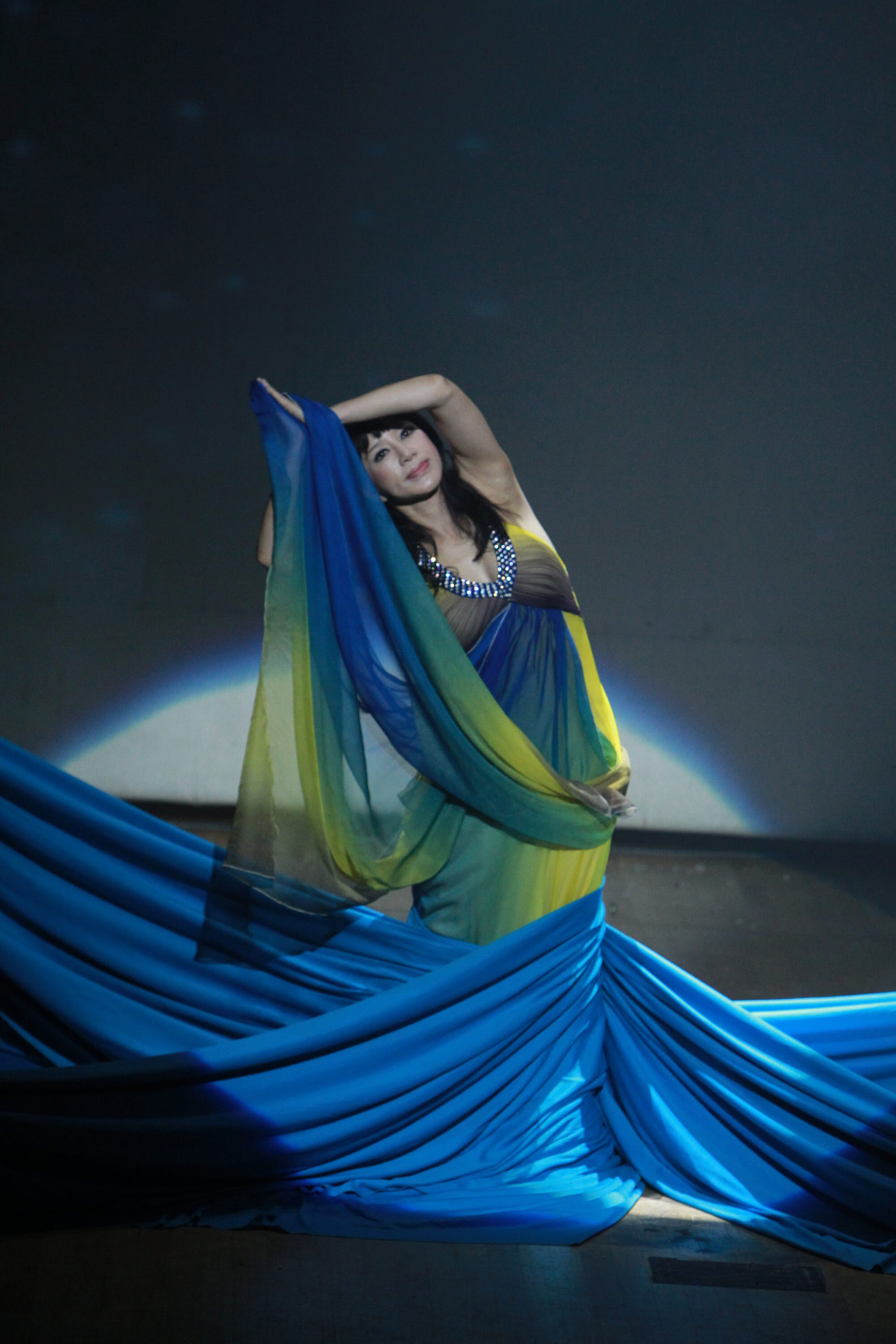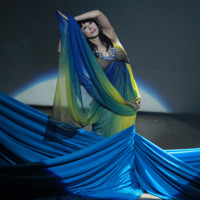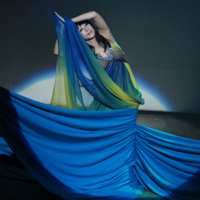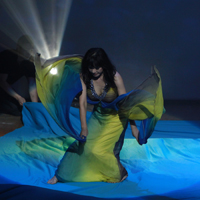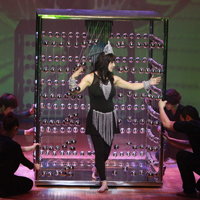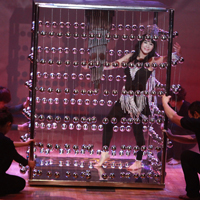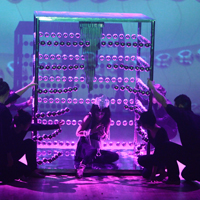Looking at the World from a Fantasy Garden
Shim Youngchurl has a very unique position in Korean contemporary art. Shim had her first solo exhibition in 1983 with a series of wood sculptures titled Comb, which showed combs in transformed shapes. Shim was inspired by the combs we use every day. Since then, Shim has crossed over into many different genres of art, from installations to new media, holograms, and performance art to environmental art, not to mention sculpture. She is truly an artist of colorful experience. She has dealt with a wide range of subjects, from individual exploration into femininity to religious messages, sexuality to historical incidents, all of which testify to her uniqueness. Shim Youngchurl’s career of thirty years as a contemporary artist shows diversity of genres and subjects, which I think originates from her natural passion for creative work. She is now in her mid-fifties, but her passion for creation remains as bright as ever.
Shim's talent as a sculptor was already evident in her early series about combs made of stone in 1983. She was attracted by the beauty of a comb and the repetition of its teeth, a small object to adorn women and a symbol of femininity. By exaggerating and transforming the basic form of a comb, Shim was recognized by her colleagues for outstanding talent and accomplishment as a sculptor. I am particularly interested in her early works because they are not only of outstanding formative beauty, but I also want to emphasize that her complex and diverse techniques in her later works are based on her outstanding artistic sense and aesthetics about sculpture. Shim was already recognized as a promising artist upon graduation from college. In the preface of the article published on the occasion of her exhibition, Professor Chung Gwan-mo lavished unreserved praise upon her work, saying, "Her aesthetic and senses are extremely sharp."
The works of the Electronic Garden series, which can be said to have set the trend of Shim's works, were results of changes in Shim's living environment. During her five years of study in the US, Shim discovered new technology and Christianity, to which she became devoted after her return home to Korea. She combined them to create new, truly original art. Throughout the 1990s, Shim continued to explore various media instead of working only with traditional materials for sculpture such as stone and wood. Shim attempted to maximize visual experience through media such as monitors and neon, and holograms, and optical fiber. Her works during this period are filled with festive mood and exorcist energies. Particularly noteworthy is that the Electronic Garden series reveals dualistic fantasy. That is, her works have sacred religious meaning, while at the same time expressing eroticism and sexual iconography. The Electronic Garden series garnered a tremendous response from art critics both from home and abroad, giving rise to a huge critical debate. The source of dualistic fantasy combining transcendental saintliness and erotic sexuality seen in her work was interpreted as a product of Shim's self-searching as a human being, and her works were interpreted as true results of her transformation through her self-searching.
After 2000, Shim began to produce the Monumental Garden series. This series seems to be a result of her compromising the limits of variable installation works as formative art and monumental formative consciousness deeply rooted inside her. The rising demand for environmental sculptures also naturally led to creation of this series. Coming out of closed spaces of exhibition halls, her installations were erected outside in natural and urban environments, providing opportunities for Shim to let her sculptures be wildly exposed to the public. Huge stone pillars reminiscent of an ancient sanctuary transformed into mushroom-like sculptures in various shapes and sizes and were installed in extended spaces. For Shim Young- churl, this journey of on-going exploration extends in direct connection from her previous works. Even the materials and subjects were all the same as those in previous years. What was different was the greater passion and competence of the artist, which allowed her to work in a city and natural space as well as indoor space. Shim's Monumental Garden aspires to be multi-media art that engenders diverse media including glass and lighting not to mention sculpture made of traditional materials. With Shim starting work as a consultant for the Korea Golf & Art Village project by an enterprise developing a multinational golf course, she began to achieve the remarkable feat of creating space by environmental sculptures where nature and art are in harmony.
Shim is now working on installation works of simple forms using stainless steel beads of various sizes. She is particularly immersed in her Shape of Sound series. This series is of flowers or square spaces of beads of about 10 centimeters in diameter. Beads hanging on vertical lines give off clear sounds as they strike each other by natural impetus from the wind, viewers’ touch, or other forces. Shim's Shape of Sound is a ‘kinetic sculpture’ in that movement is an important element, and it is also ‘sound sculpture' in that sound is used as an element to perceive the space. Furthermore, it is 'light sculpture' which emphasizes the effect of light reflected on the surfaces of stainless steel beads, and it is 'image sculpture' in that surrounding images reflected on the surfaces of the beads create mysterious space captured by fisheye lens. Shape of Sound is a multi-dimensional sculpture embracing movement and sound, and light and images. It expands the territory of sculpture as artwork that elicits viewers’ participation coupled with varied formative beauty.
Shim recently installed a series of Shape of Sound on the upper part of the escalator of Opera House Square of Seoul Arts Center. This piece is an installation work made of stainless steel beads and still shows completed effects as a monumental artwork. The huge petal-shaped piece endears itself to the surrounding spaces of an escalator. Sometimes, air flowing in from outside makes the beads move and strike each other and make clear sounds. Lighting installed in ordinary space below this piece reflects off the hundreds of beads, making the work sparkle like jewelry. The images of viewers riding the escalator are, likewise, scattered on the surfaces of the hundreds of beads, bringing the viewers for a moment into an otherworldly environment. Shim's installation work is, thus, linked to the place where it is installed, and it arouses a different kind of inspiration and meaning depending on conditions in which it is placed.
Another type of work from the Shape of Sound series shows threaded stainless steel beads hanging down like a curtain all around the square steel structure. On this square structure is a mirror such that the curtain image is extended to the bottom. Unlike other works showing specific formative images, this piece is intended as a space for performance. The artist invites viewers into an inner space and wants them to share the memories of sound the artist herself experienced. Touching the curtain of beads as if smoothing down walls, she wants desire for narcissism to shoot out on the hundreds of images reflected off of these beads. Thus, the bead curtain functions as both a space of experience and a space of deep reflection.
Shim's art is always on the border. Her art straddles the border between diverse genres and media, but interfaces where fragments of consciousness flowing inside meet while conflicting with each other. In reverse order, her pursuit of the boundary can be seen as a factor that makes Shim’s work rich and full of vitality. Shim’s creative energy arises where the boundaries between genres are blurred and reconstructed. Her artistic journey, which may seem childish at times, contradictory or unfinished at other times, resists being evaluated by aesthetic perfection or the criteria of critics. If the journey of life is a process of thinking about boundaries of good and evil, truth and hypocrisy, and beauty and ugliness, and if art reveals such process, Shim Young-churl's thoughts about the boundary as a source of energy flowing on the foundation of her work ensure the authenticity of her works.
Kim Young-ho (Art Critic, Professor of Chung-Ang University)
more
In Search of Messiah in the Electronic Age
Prologue
It is not easy to define in a word the artistic realm of Youngchurl Shim, who started out her career in traditional sculpture, but then expanded the boundaries to include new media and technology. During the last 25 years of her career, which began with the Phased Representation of Comb that used wood and stone to represent different shapes of the comb, Shim’s techniques and mediums covered a wide spectrum from installation art using neon and hologram to video images and performances. Even her installation art knows no boundaries ? Electronic Garden was staged indoors, but the following Monumental Garden series was taken to outdoors and greater urban areas, and even to the subways. Looking from the perspective of Arthur Danto, who defined the situations after the “end of art” as the era of modern art, Shim’s enthusiastic ventures into different areas demonstrate that we have truly entered the era of “artistic pluralism.”
Despite the diversity of mediums, expressive methods, and installation locales observed in the works of Shim, the common thread that runs through her artistic tapestry is religion. This religious significance, which will be discussed further in the latter part of this writing, may be a guideline that helps you navigate through Shim’s artistic realm. Finding religious meanings is a worthy effort, for religion provides an alternative to artists living in today’s chaotic artistic environment. To modern men, who live in the era where orthodox theories of art history are being dismantled and the mainstream historic ideologies picked apart, the religious interpretation of art can be regarded as two things ? an index that helps identify passion and obedience, and contradiction and aimlessness, as well as a principle that analyzes modern life that is much like a piece of cloth woven with freedom and constraints.
Shin has consistently applied such religious messages as holy spirit, pilgrim, existence, and providence to the works throughout her nearly two-decade0long career, which began with a solo exhibition entitled Jesus Love You held at Dongsung Art Center after returning to Korea in 1989 from her five-year studies in the United States at UCLA, Otis-Parsons and Golden State University. Those messages are present in the titles of her exhibitions and performances thenceforth ? Humans, Where Are We From? Where Are We Now? And Where Are We Going? (1990), God Controls Life and Death (1992), Providence ? Longing, Adversity, Resignation, Meaning of Life and Harmony (1993), Providence ? Beautiful One (1995), Providence ? Adversity to Endurance, Endurance to Purification, Purification to attain Aspired (1997), and Pilgrim (2000). She also showed that her works were built upon “God’s Word” by setting up stone pillars signifying the temple and images of Jesus at her solo exhibition Monumental Garden for the Environment (2002) held at the Insa Art Center.
Art theorist Jae-kwon Kim summarized Shim’s art into one phrase ? “the maximization of communication through multiple channels.” Kim arranged Shim’s self-retrospect and transformation by era and found out that her multiple channels were all pointing at “the world of God.” Other critiques on Shim’s art also singled out the transmission of religious messages through various channels as the purpose of her works. Her personal perspective, which defined art as “an activity that exposes one’s spirit,” was what drove her to endow such religious themes to her works. Nonetheless, one cannot downplay the external influence her family had on her works, particularly that from her older sister who is a pastor.
It is not easy to define in a word the artistic realm of Youngchurl Shim, who started out her career in traditional sculpture, but then expanded the boundaries to include new media and technology. During the last 25 years of her career, which began with the Phased Representation of Comb that used wood and stone to represent different shapes of the comb, Shim’s techniques and mediums covered a wide spectrum from installation art using neon and hologram to video images and performances. Even her installation art knows no boundaries ? Electronic Garden was staged indoors, but the following Monumental Garden series was taken to outdoors and greater urban areas, and even to the subways. Looking from the perspective of Arthur Danto, who defined the situations after the “end of art” as the era of modern art, Shim’s enthusiastic ventures into different areas demonstrate that we have truly entered the era of “artistic pluralism.”
Despite the diversity of mediums, expressive methods, and installation locales observed in the works of Shim, the common thread that runs through her artistic tapestry is religion. This religious significance, which will be discussed further in the latter part of this writing, may be a guideline that helps you navigate through Shim’s artistic realm. Finding religious meanings is a worthy effort, for religion provides an alternative to artists living in today’s chaotic artistic environment. To modern men, who live in the era where orthodox theories of art history are being dismantled and the mainstream historic ideologies picked apart, the religious interpretation of art can be regarded as two things ? an index that helps identify passion and obedience, and contradiction and aimlessness, as well as a principle that analyzes modern life that is much like a piece of cloth woven with freedom and constraints.
Shin has consistently applied such religious messages as holy spirit, pilgrim, existence, and providence to the works throughout her nearly two-decade0long career, which began with a solo exhibition entitled Jesus Love You held at Dongsung Art Center after returning to Korea in 1989 from her five-year studies in the United States at UCLA, Otis-Parsons and Golden State University. Those messages are present in the titles of her exhibitions and performances thenceforth ? Humans, Where Are We From? Where Are We Now? And Where Are We Going? (1990), God Controls Life and Death (1992), Providence ? Longing, Adversity, Resignation, Meaning of Life and Harmony (1993), Providence ? Beautiful One (1995), Providence ? Adversity to Endurance, Endurance to Purification, Purification to attain Aspired (1997), and Pilgrim (2000). She also showed that her works were built upon “God’s Word” by setting up stone pillars signifying the temple and images of Jesus at her solo exhibition Monumental Garden for the Environment (2002) held at the Insa Art Center.
Art theorist Jae-kwon Kim summarized Shim’s art into one phrase ? “the maximization of communication through multiple channels.” Kim arranged Shim’s self-retrospect and transformation by era and found out that her multiple channels were all pointing at “the world of God.” Other critiques on Shim’s art also singled out the transmission of religious messages through various channels as the purpose of her works. Her personal perspective, which defined art as “an activity that exposes one’s spirit,” was what drove her to endow such religious themes to her works. Nonetheless, one cannot downplay the external influence her family had on her works, particularly that from her older sister who is a pastor.
Vestiges of 25 years : Categorization by Style
As mentioned above, Shim’s works show the attributes of pluralism often seen in the age of modern art following the “end of art.” Thus it’s not easy to categorize the contents and forms of her works into one specific style. Nevertheless, it is necessary to divide her works into several groups for a detailed analysis, for she has produced a number of works and materials for over two decades since her first solo exhibition in 1983. In doing so, it would be right to classify her works by style, rather than by chronological order. Her works can also be sorted by themes, such as the shape of comb, message of God, electronic garden, monumental garden, and cyber space. The classification by both expressive style and theme yields the following six categories.
As mentioned above, Shim’s works show the attributes of pluralism often seen in the age of modern art following the “end of art.” Thus it’s not easy to categorize the contents and forms of her works into one specific style. Nevertheless, it is necessary to divide her works into several groups for a detailed analysis, for she has produced a number of works and materials for over two decades since her first solo exhibition in 1983. In doing so, it would be right to classify her works by style, rather than by chronological order. Her works can also be sorted by themes, such as the shape of comb, message of God, electronic garden, monumental garden, and cyber space. The classification by both expressive style and theme yields the following six categories.
1. Shape of the comb ? Sculpture
2. Message of God ? Installation art
3. Electronic Garden ? Technology art
4. Monumental Garden ? Public art
5. Cyber space ? Relief
6. Performance & Video art
2. Message of God ? Installation art
3. Electronic Garden ? Technology art
4. Monumental Garden ? Public art
5. Cyber space ? Relief
6. Performance & Video art
Shape of the Comb, which belongs in the field of traditional sculpture, demonstrated Shim’s outstanding figurative sense as a sculptor. It’s a byproduct of modular reflection of the comb, an everyday personal care tool and a necessity for women. Shim showed special interest in variations by naming those comb sculptures, which resemble totem poles of ancient tribes, the Phased Representation of Comb. Kwan-mo Chung, Shim’s supervising professor during her graduate school years, wrote in the preface of her first solo exhibition, “She conceptualized the basic characteristics of the comb, which became the basis for her sculpture pieces, and attempted to find her own formative language by maximizing or transforming that basis.” Chung also gave her high marks for using traditional Korean props for her works. In fact, the repetition of comb teeth and the form that generated intense structural beauty are enough to inspire Shim’s artistic drive. She wrote in the notebook that she “cannot forget how comb teeth shed shadows by the light of sunset and how the language hidden in those shadows took me to peaceful serenity.”
It became evident that Shim’s artistic pursuit has taken a different turn from the previous one, judging from the works with a religious overtone introduced in her solo exhibition after her return from the U.S. She gave the title Message of God to a series of works, while gradually shifting toward installation art from traditional sculpture in terms of expressive mode. At the time God’s message interpreted by Shim was represented by a window shedding the light of redemption. This window appeared to open toward the internal, showing a glimpse of a wounded soul or traces of pain and suffering. Sharp marks of a carving knife on the surface of the wooden window will resembled the gashes from ship lashing, which helped link the properties of wood to the image of Jesus’ wounds and strengthened the narrative of the Cross that penetrates through the mere thickness of the window. Such image of the window was expanded into the hologram-type three-dimensional video images, which stressed the effect of light and offered a symbolic message of life and redemption.
Meanwhile, the installation of the Message of God series reached its culmination when 1,500 volumes of Bible were piled up like a pyramid or opened up with the neon lights. Moreover, thorny branches or barbed wires were used to represent Jesus’ Crown of Thorns or hands of the crowd. The visual symbolism of these messages was still confined to the sphere of the narrative, but, by rigorously attempting to combine religion and art, helped to shape Shim’s artistic image.
The Electronic Garden series was successful in building a unique world of shapes by incorporating religious messages into technology. Judging from the context of modern art, this series not only employed a variety of sculpting techniques and mediums of the era, but also explored a new frontier beyond the conventional boundaries without being overwhelmed by the narrative structure of religious themes. As art critic Il Lee pointed out around the time Shim held her third solo exhibition in 1990, Shim’s challenge was “the conflict between the religious messages and the method of encapsulating those messages according to her modeling system.” But starting with Electronic Garden in 1993, the challenge was to move away from “merely interpreting the Bible” to asserting her own formative expression in the context of modern art by employing all methods, techniques, and materials to give concrete forms to the messages. Shim’s Electronic Garden presented at the Techno Art Exhibition at the Daejeon Expo was “an integration of nature and technology, which had tens of tree trunks installed with monitors showing flowers blossoming at a touch of the screen, moving cylinder-shaped holograms, neon signs flashing in the shape of flowers, and undulating optic fibers (Jae-kwon Kim).” Having become her trademark for the decade that followed, Electronic Garden had embodied both the artificial paradise and the volatile madness of modern science.
Monumental Garden was created in response to the limitations of variable installation art and the era that calls for the production of public artworks. In particular, the temporal and spatial limitations inherent in electronic devices and installation art may have compelled Shim to turn her eyes toward the monumental attribute of environmental structures. Much like the Electronic Garden series, the early works of Monumental Garden covered various mediums and techniques and the main theme centered on religious messages. After sometime, however, it became obvious that the works actually exposed her life and the world of peripheral desires. What appeared at this time were giant stone pillars reminiscent of temples and mushrooms of various shapes and sizes that added variations to the pillars. The images of mushrooms seen throughout Shim’s works were a principle that guided her artistic vision to unique surroundings. Then she had put some distance between her art and religious tenets or rules, which had liberated her ironically to attain a more enthusiastic religious perspective that motivated her to apply religious messages to her own life by artistically transforming human desires.
Shim’s relief works were also the products of public art infused with environmental elements, because the works of haut-relief and bas-relief were used to decorate the walls. Shim showed a particular attachment to this style, manifest in the combination of small panels. Her relief works provided another glimpse into her formative ability and sensitivity once displayed in Phased Representation of Comb.
Lastly, Shim’s performances and video works are extreme examples of her use of multiple expressive techniques. The themes largely involved religious and historical events, as in a performance where she was dressed as Empress Myung-seong, Joseon Dynasty’s last empress, I commemoration of the March 1 uprising during the Japanese colonial regime and in “Pilgrim,” presented at the International Performance Art Festival hosted in Jooksan, Korea in 2000. Since her works typically emphasize certain themes, her performances do not stray that much from narrative art. Video works also carry out supporting role for installation art pieces.
It became evident that Shim’s artistic pursuit has taken a different turn from the previous one, judging from the works with a religious overtone introduced in her solo exhibition after her return from the U.S. She gave the title Message of God to a series of works, while gradually shifting toward installation art from traditional sculpture in terms of expressive mode. At the time God’s message interpreted by Shim was represented by a window shedding the light of redemption. This window appeared to open toward the internal, showing a glimpse of a wounded soul or traces of pain and suffering. Sharp marks of a carving knife on the surface of the wooden window will resembled the gashes from ship lashing, which helped link the properties of wood to the image of Jesus’ wounds and strengthened the narrative of the Cross that penetrates through the mere thickness of the window. Such image of the window was expanded into the hologram-type three-dimensional video images, which stressed the effect of light and offered a symbolic message of life and redemption.
Meanwhile, the installation of the Message of God series reached its culmination when 1,500 volumes of Bible were piled up like a pyramid or opened up with the neon lights. Moreover, thorny branches or barbed wires were used to represent Jesus’ Crown of Thorns or hands of the crowd. The visual symbolism of these messages was still confined to the sphere of the narrative, but, by rigorously attempting to combine religion and art, helped to shape Shim’s artistic image.
The Electronic Garden series was successful in building a unique world of shapes by incorporating religious messages into technology. Judging from the context of modern art, this series not only employed a variety of sculpting techniques and mediums of the era, but also explored a new frontier beyond the conventional boundaries without being overwhelmed by the narrative structure of religious themes. As art critic Il Lee pointed out around the time Shim held her third solo exhibition in 1990, Shim’s challenge was “the conflict between the religious messages and the method of encapsulating those messages according to her modeling system.” But starting with Electronic Garden in 1993, the challenge was to move away from “merely interpreting the Bible” to asserting her own formative expression in the context of modern art by employing all methods, techniques, and materials to give concrete forms to the messages. Shim’s Electronic Garden presented at the Techno Art Exhibition at the Daejeon Expo was “an integration of nature and technology, which had tens of tree trunks installed with monitors showing flowers blossoming at a touch of the screen, moving cylinder-shaped holograms, neon signs flashing in the shape of flowers, and undulating optic fibers (Jae-kwon Kim).” Having become her trademark for the decade that followed, Electronic Garden had embodied both the artificial paradise and the volatile madness of modern science.
Monumental Garden was created in response to the limitations of variable installation art and the era that calls for the production of public artworks. In particular, the temporal and spatial limitations inherent in electronic devices and installation art may have compelled Shim to turn her eyes toward the monumental attribute of environmental structures. Much like the Electronic Garden series, the early works of Monumental Garden covered various mediums and techniques and the main theme centered on religious messages. After sometime, however, it became obvious that the works actually exposed her life and the world of peripheral desires. What appeared at this time were giant stone pillars reminiscent of temples and mushrooms of various shapes and sizes that added variations to the pillars. The images of mushrooms seen throughout Shim’s works were a principle that guided her artistic vision to unique surroundings. Then she had put some distance between her art and religious tenets or rules, which had liberated her ironically to attain a more enthusiastic religious perspective that motivated her to apply religious messages to her own life by artistically transforming human desires.
Shim’s relief works were also the products of public art infused with environmental elements, because the works of haut-relief and bas-relief were used to decorate the walls. Shim showed a particular attachment to this style, manifest in the combination of small panels. Her relief works provided another glimpse into her formative ability and sensitivity once displayed in Phased Representation of Comb.
Lastly, Shim’s performances and video works are extreme examples of her use of multiple expressive techniques. The themes largely involved religious and historical events, as in a performance where she was dressed as Empress Myung-seong, Joseon Dynasty’s last empress, I commemoration of the March 1 uprising during the Japanese colonial regime and in “Pilgrim,” presented at the International Performance Art Festival hosted in Jooksan, Korea in 2000. Since her works typically emphasize certain themes, her performances do not stray that much from narrative art. Video works also carry out supporting role for installation art pieces.
The Meaning of Message of God
Having categorized Shims’ works into different styles, I feel the need to take a cautious approach to the critique that her works are built upon religious concepts. That is because, in spite of the fact that her works symbolize the words of God, hardly any theological or ethical values or immutable aura taught by the Church are detected in the works. Shim sees the world through universal concepts, that is, such changing values as life and death, love and conflict, yearnings and trials, and eroticism and desires. That’s why we should guard against the attitude that concludes Shim’s art as mere dogmatic principles of faith, as such attitude can distort and bind the interpretations of her artistic world.
The religious nature of Christianity endorses action based on faith, a system of rules and ethics, and the faith is given the liberty of interpretation or explanation within the confines of completed text (the Bible). Here we need to clearly identify the differences and similarities among religion, life, and art. That is, religion needs to be regarded as a universal value that is linked with the variety of life, away from the exclusive confines of Zionism. Once we acknowledge this point, we will be able to discover that a wide range of discourses on love, aimlessness, suffering, obedience, betrayal, passion, and depravity found in her works are closely related to the phenomena of secular life hidden under the facade of religious rules and absoluteness.
In Shim’s works I detect an aspect of modern men possessing the attributes of “disintegrated subject” or “dual self” that oscillates between the “Words” of Christ and secular desires. In other words, our duality is men’s desire to deny God as an absolute being from which we cannot excape and a portrayal of our loneliness and complications generated from knowing that truth, virtue, and beauty can be transected by falsity, vice, and ugliness. It is not that difficult to realize that these emotions by no means stem from the negation or loss of Christian faith, but from the resistance to find oneself in the reality of religion, and that they are the energy that sustains the artist’s life. Just like Adam and Eve who betrayed God, isn’t the artist wavering between the longings for the godly realm and the dual self that wants to escape from it? However, her conflicting thoughts are more or less pacified through the creation of artworks, which keeps her life healthy. Examined from the perspective of Jacques Lacan, who rebelled against centralism by dissecting the subject and attempted to resurrect instincts and eroticism, we can find from Shim’s works the very picture of ourselves who have become psychologically alienated from our inner selves. Given that, it appears the code of communication has been established between the producers of art and the public, because people can agree with the potentials of modern art that ensures free will and broadens the scope of life.
In Shim’s works produced in the new millennia we can see the commonalities and differences found in that gave her a chance to reflect upon the last two decades of her career. The works done during those years still demonstrate the presence of previously established themes, but, at the same time, show her endeavors to express them in her own language. “Monumental Garden” summarized these concepts, which are connected not only to the dual world of fantasia, but also to nature, ecosystem, technology, and the whole environment. It is also undisputed that these ideas contain environmental elements that an individual experiences in an electronic age and a host of very personal experiences and values. This is why Shim explored various styles and thus she cannot be criticized for using everything from stones, trees, earth, sand, pebbles, salt, water, and fire to glass, steel, plastic, neon, optic fibers, hologram, and artificial skin. What Shim wishes to seek by integrating all these different styles and mediums is the Messiah of the total environment or of the electronic age, and that Messiah is none other than an entity that can be met during the process of artistic expressions and interpretations.
Having categorized Shims’ works into different styles, I feel the need to take a cautious approach to the critique that her works are built upon religious concepts. That is because, in spite of the fact that her works symbolize the words of God, hardly any theological or ethical values or immutable aura taught by the Church are detected in the works. Shim sees the world through universal concepts, that is, such changing values as life and death, love and conflict, yearnings and trials, and eroticism and desires. That’s why we should guard against the attitude that concludes Shim’s art as mere dogmatic principles of faith, as such attitude can distort and bind the interpretations of her artistic world.
The religious nature of Christianity endorses action based on faith, a system of rules and ethics, and the faith is given the liberty of interpretation or explanation within the confines of completed text (the Bible). Here we need to clearly identify the differences and similarities among religion, life, and art. That is, religion needs to be regarded as a universal value that is linked with the variety of life, away from the exclusive confines of Zionism. Once we acknowledge this point, we will be able to discover that a wide range of discourses on love, aimlessness, suffering, obedience, betrayal, passion, and depravity found in her works are closely related to the phenomena of secular life hidden under the facade of religious rules and absoluteness.
In Shim’s works I detect an aspect of modern men possessing the attributes of “disintegrated subject” or “dual self” that oscillates between the “Words” of Christ and secular desires. In other words, our duality is men’s desire to deny God as an absolute being from which we cannot excape and a portrayal of our loneliness and complications generated from knowing that truth, virtue, and beauty can be transected by falsity, vice, and ugliness. It is not that difficult to realize that these emotions by no means stem from the negation or loss of Christian faith, but from the resistance to find oneself in the reality of religion, and that they are the energy that sustains the artist’s life. Just like Adam and Eve who betrayed God, isn’t the artist wavering between the longings for the godly realm and the dual self that wants to escape from it? However, her conflicting thoughts are more or less pacified through the creation of artworks, which keeps her life healthy. Examined from the perspective of Jacques Lacan, who rebelled against centralism by dissecting the subject and attempted to resurrect instincts and eroticism, we can find from Shim’s works the very picture of ourselves who have become psychologically alienated from our inner selves. Given that, it appears the code of communication has been established between the producers of art and the public, because people can agree with the potentials of modern art that ensures free will and broadens the scope of life.
In Shim’s works produced in the new millennia we can see the commonalities and differences found in that gave her a chance to reflect upon the last two decades of her career. The works done during those years still demonstrate the presence of previously established themes, but, at the same time, show her endeavors to express them in her own language. “Monumental Garden” summarized these concepts, which are connected not only to the dual world of fantasia, but also to nature, ecosystem, technology, and the whole environment. It is also undisputed that these ideas contain environmental elements that an individual experiences in an electronic age and a host of very personal experiences and values. This is why Shim explored various styles and thus she cannot be criticized for using everything from stones, trees, earth, sand, pebbles, salt, water, and fire to glass, steel, plastic, neon, optic fibers, hologram, and artificial skin. What Shim wishes to seek by integrating all these different styles and mediums is the Messiah of the total environment or of the electronic age, and that Messiah is none other than an entity that can be met during the process of artistic expressions and interpretations.
Dual Fantasia : Sex and Sanctity
Shim’s art with religious overtone shows a world of dual fantasia. As mentioned above, it is a world that cannot be explained merely by dogmatic religious principles and logic. Instead it’s better to conceive it as a world formed by traversing both secular life and art. Here the dual fantasia of sex and sanctity is proposed as a new key word to understand Shim’s art. Actually the concept of dual fantasia was easily found among enthusiastic Korean artists since the 1980s, if not in the critique theories of pluralism or post-modernism. However, it is rare to find that one concept shaping the artistic world of one artist, which is not even possible if the artist is not someone of unique life pattern and character. That is because the symbolization of an artist’s topic and crashing concepts, as well as the conflicts themselves, must be premised on a life filled with aimlessness and challenges, as well as equally strong commitment and capabilities, for “art is a reflection of life’s intensity.”
Young-churl Shim that I know possesses such unique personality. People who knew her during college all speak of her great passion and willpower. Shim’s passionate personality manifested itself as an “artistic knack,” which compelled her to walk intrepidly down the path of reform that crisscrosses the realms of various mediums and styles. Unlike art that thrives on departure from the norm, however, the ethical views and rules of Christianity, her family’s faith, may have paradoxically stimulated her stance on art. Just as the Christian doctrine that pursues life after death also functions to complete secular life, the confrontation between two different realms spurred on an in-depth exploration of two different concepts. From this perspective we can see that the meanings of sex and sanctity making up Shim’s dual fantasia are in a complementary relationship.
It’s worth noting that the world of religious sanctity displayed in Shim’s works as an artistic topic is portrayed through the means of scientific technology, such as neon, optic fibers, hologram, and video. As seen in Electronic Garden, the religious properties revealed by the new mediums representing reason and rationality are thus consecrated not by the traditional realm of faith, but rather by science. The video installation with technology as their modular principle combines the transcendental and mystical world with the rational world, reflecting the sensibility of the age we live in. Religion in the era of science paradoxically provides new values to modern society. Then what meanings does the encounter of science and religion have in today’s realm of art? Does the union of three elements ? art, science, and religion ? endow individuality to Shim’s works? Can the Messiah Shim’s searching for through her works symbolize the ideal of the electronic age or aesthetic extravagance?
Sex often appearing in Shim’s works as a physiological concept is generated from the point where religious sanctity and scientific technology converge with actual desires. Her works reflect the desires of men dreaming of Eden on the hills of secular world, where human instincts of desire are amplified, as in the argument of psychologist Jacques Lacan. The world of sanctity adorning “Electronic Garden” can be observed in the Crown of Thorn or the Crucifix, the glory of Jesus Christ, but it’s also not that difficult to find sexual connotations there. For instance, the shape of mushrooms seen in Beautiful God implicitly points to eroticism and the image of phallus in “Noah’s Art” is indeed shocking. Art critic Tae-man Choi explained in his preface to Shim’s solo exhibition that the twisted shape of mushrooms is suggestive of “life’s ecstasy, pleasure, desire” and even “the mystery of life, creation, and abundance.” Given that, the sexual connotations and personal interest and longings related to them evident in Shim’s works transcend the level of simple sexual intercourse and linked to the issues in anthropology, mythology, psychology and psychoanalysis.
When mushrooms, colorful and multi-shaped symbol of sensuality and desire, are harmonized with the psychedelic colors of hologram and neon lights, the world thus created is a realm of symbols that combine sex and sanctity. Such erotic discourse on sex frequently appears on video works of Shim’s favorite Adam and Eve. The dual expressions of religious sanctity and erotic sex are integrated in a paradoxical way and the meanings born in the structures of visual expression are found first in mythology and religion and later blended with the bright lights of the electronic age, but they are ultimately crystallized as a formative language that supports the artist’s works.
Shim’s art with religious overtone shows a world of dual fantasia. As mentioned above, it is a world that cannot be explained merely by dogmatic religious principles and logic. Instead it’s better to conceive it as a world formed by traversing both secular life and art. Here the dual fantasia of sex and sanctity is proposed as a new key word to understand Shim’s art. Actually the concept of dual fantasia was easily found among enthusiastic Korean artists since the 1980s, if not in the critique theories of pluralism or post-modernism. However, it is rare to find that one concept shaping the artistic world of one artist, which is not even possible if the artist is not someone of unique life pattern and character. That is because the symbolization of an artist’s topic and crashing concepts, as well as the conflicts themselves, must be premised on a life filled with aimlessness and challenges, as well as equally strong commitment and capabilities, for “art is a reflection of life’s intensity.”
Young-churl Shim that I know possesses such unique personality. People who knew her during college all speak of her great passion and willpower. Shim’s passionate personality manifested itself as an “artistic knack,” which compelled her to walk intrepidly down the path of reform that crisscrosses the realms of various mediums and styles. Unlike art that thrives on departure from the norm, however, the ethical views and rules of Christianity, her family’s faith, may have paradoxically stimulated her stance on art. Just as the Christian doctrine that pursues life after death also functions to complete secular life, the confrontation between two different realms spurred on an in-depth exploration of two different concepts. From this perspective we can see that the meanings of sex and sanctity making up Shim’s dual fantasia are in a complementary relationship.
It’s worth noting that the world of religious sanctity displayed in Shim’s works as an artistic topic is portrayed through the means of scientific technology, such as neon, optic fibers, hologram, and video. As seen in Electronic Garden, the religious properties revealed by the new mediums representing reason and rationality are thus consecrated not by the traditional realm of faith, but rather by science. The video installation with technology as their modular principle combines the transcendental and mystical world with the rational world, reflecting the sensibility of the age we live in. Religion in the era of science paradoxically provides new values to modern society. Then what meanings does the encounter of science and religion have in today’s realm of art? Does the union of three elements ? art, science, and religion ? endow individuality to Shim’s works? Can the Messiah Shim’s searching for through her works symbolize the ideal of the electronic age or aesthetic extravagance?
Sex often appearing in Shim’s works as a physiological concept is generated from the point where religious sanctity and scientific technology converge with actual desires. Her works reflect the desires of men dreaming of Eden on the hills of secular world, where human instincts of desire are amplified, as in the argument of psychologist Jacques Lacan. The world of sanctity adorning “Electronic Garden” can be observed in the Crown of Thorn or the Crucifix, the glory of Jesus Christ, but it’s also not that difficult to find sexual connotations there. For instance, the shape of mushrooms seen in Beautiful God implicitly points to eroticism and the image of phallus in “Noah’s Art” is indeed shocking. Art critic Tae-man Choi explained in his preface to Shim’s solo exhibition that the twisted shape of mushrooms is suggestive of “life’s ecstasy, pleasure, desire” and even “the mystery of life, creation, and abundance.” Given that, the sexual connotations and personal interest and longings related to them evident in Shim’s works transcend the level of simple sexual intercourse and linked to the issues in anthropology, mythology, psychology and psychoanalysis.
When mushrooms, colorful and multi-shaped symbol of sensuality and desire, are harmonized with the psychedelic colors of hologram and neon lights, the world thus created is a realm of symbols that combine sex and sanctity. Such erotic discourse on sex frequently appears on video works of Shim’s favorite Adam and Eve. The dual expressions of religious sanctity and erotic sex are integrated in a paradoxical way and the meanings born in the structures of visual expression are found first in mythology and religion and later blended with the bright lights of the electronic age, but they are ultimately crystallized as a formative language that supports the artist’s works.
Epilogue
Just as we describe the mystery of natural phenomenon as “sublime,” nature’s mystery discovered by technology often leads us to appreciate the sublime beauty of religion. The endless expanse of the universe uncovered by astronomical telescopes may slash away at the veil of mystery and sublimity surrounding natural phenomena. Just looking at the power of the internet media, we realize that scientific discoveries, “as pleasure accompanied by fear,” always coexist with the infinite feeling of sublimity and that, in the end, the world order is not totally removed from the world of religious mysteries. Advanced science may be a tool that peels away the layers of mystery, but you will soon find out that the more you peel away, the more inexplicable nature’s mystery becomes. Eventually you will get to admit that nature oversees birth and death and leads to the world of the “Prime Cause.”
It may to too much to say that the feelings experienced by the audience of Shim’s Electronic Garden or Monumental Garden are the emotions of “sublimity.” That’s because her worlds of “monitors showing flowers blossoming at a touch of the screen, moving cylinder-shaped holograms, neon signs flashing in the shape of flowers, and undulating optic fibers” do not impart pleasure accompanying fear, but rather a playful and decorative joy. However, it’s undeniable that the aesthetic meanings, created when her attempts to combine nature and technology are consecrated with religious concepts, lead us to the realm of sublimity.
To Shim Monumental Garden is a garden where her life is cultivated. The Messiah living in that garden may be understood as an entity that controls the desires of human beings living in an electronic age. As people’s longing for the Messiah intensifies, however, their secular desire also become stronger, which again fuels their yearnings for the Messiah. It is clear that Shim’s art functions as the garden of the Messiah, balancing out two conflicting extremes, just like Louise Bourgeois and other celebrated figures of modern art, who could only have sustained their lives by producing artworks with a multitude of styles. Therefore, Shim’s works can be called the Garden of Eden in an electronic age, and suggest that you heed the message of human ecstasy and pain, and sublimity and desires blossoming in that garden.
Young-ho KIM (Art historian, Art critic)
more






